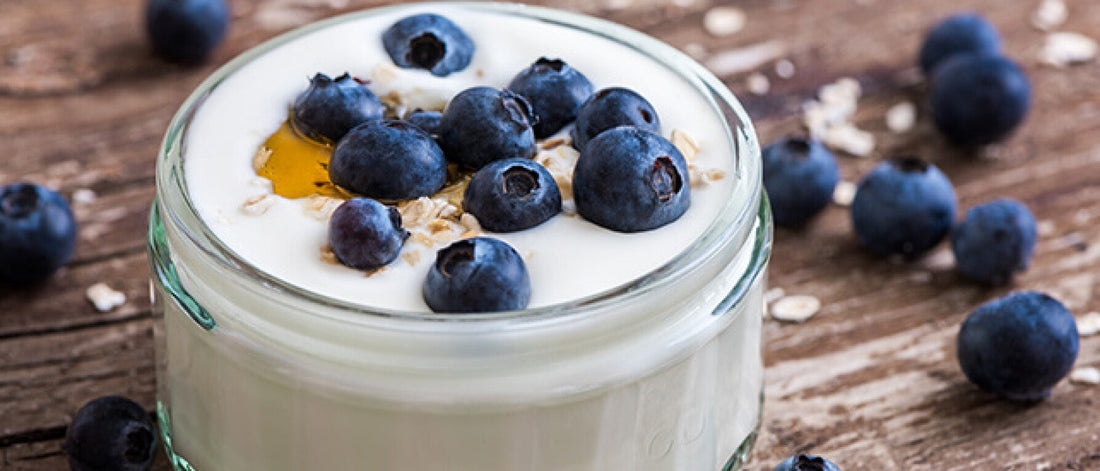The digestive tract works like an assembly line in reverse. Instead of creating food, the digestive tract breaks it down into basic parts to make it easier to absorb and metabolize. As efficient as the digestive tract is, a large portion of the energy stored in food is not processed and metabolized by the human body. Undigested food travels through the intestinal tract and is often fermented and metabolized by the gut microbiome, the microscopic organisms that live within the digestive tract.
These microbes have the ability to digest and metabolize the food content we cannot as well as release absorbable nutrients, metabolites, and waste products. A number of these metabolites, such as vitamin K, cannot be produced by the human body yet are critical for our survival. Other metabolites have biological activity that can influence human health and behavior. Each of the thousands of species that comprise the gut microbiome can have unique consequences on health, depending on the host genetic makeup, environment, and the other components of the microbiome.
The nerve cells and fibers within the digestive tract are known as the enteric nervous system, and are connected to the brain and central nervous system. The vagus nerve is a major cranial nerve that connects the brain and the gut, as well as other organs. The gut microbiome and diet produce and contain metabolites that communicate with the brain and central nervous system via the vagus nerve as well as by alternative routes, including the circulatory, endocrine, and immune systems.
Serotonin is the major neurotransmitter involved in mood, with most antidepressants designed to work by increasing its levels. Only five percent of the serotonin of the body is found in the brain; the other 95 percent is found in the gut. There are more than 30 active neurotransmitters found throughout the enteric nervous system, underlying its importance and interconnection with the central nervous system. Many experts consider the gut to be the equivalent of a second brain.
The populations and varieties of organisms in the gut microbiome are staggering. To date, more than 5,000 different species have been identified, and some scientists expect the number may reach a million or more before the counting is complete. The populations and diversity vary by location within the gut, as well as age, diet, and a multitude of other factors. Much like a fingerprint, it appears that the gut microbiome may be unique for each individual. It can also be disrupted by illness, change in diet, and the ingestion of antibiotics.
Research into the consequences of each microbial species, and how it interacts with the unique genetic makeup of each individual, is just beginning. It will take many decades to fully understand the gut microbiome, and what is optimal for each individual. Modifying the microbiome by ingesting probiotics has become popular, and probiotic supplements are heavily marketed by manufacturers. For most individuals, the best approach is consuming a well-balanced, diverse diet that includes naturally fermented foods such as yogurt, kefir, kimchi, sauerkraut, and pickled vegetables.
When a blood specimen is analyzed using genomic sequencing, approximately 20 percent of the metabolites in the circulation are of microbial origin, and some may be playing a major role in human health and disease. A landmark study published in The New England Journal of Medicine demonstrated that microbial metabolites may increase the risk of atherosclerosis and cardiovascular disease.
The interplay between the gut, microbiome, and brain is striking. The direction of communication is perhaps even more remarkable. Although we like to think our brains are in charge, the majority of communication doesn’t flow from the brain to the gut, but in the other direction. The vagus nerve, also known as cranial nerve eight, is the major nerve connecting the brain and the gut. Over eighty percent of the communication via the vagus nerve is transmitted from the gut to the brain.
For example, if you were to eat hay or grass, the cellulose of the plant would not be digestible because the human body doesn’t have cellulase, the enzyme required to break it down into absorbable sugars. Horses, cows, and sheep have this enzyme, as well as a ruminant digestive tract, to process these substances. When we eat prebiotic fiber (pass on the hay!), the microbes ferment and digest it into nutrients that we can absorb. This means that microbes can digest so-called zero-calorie foods and provide us with calories we may not have counted.
While there may be some general categories of probiotics that have benefits, the identification of the ideal microbiome for each individual is still a long ways off. Picking the right probiotic, or mix of probiotics, for a general population is as challenging as selecting a fragrance that is right for every person living in a town. Most of the population may do well with certain base fragrances such as jasmine or musk, but the concentration of the essence and the final aroma is dependent on other ingredients and the chemistry of the individual. It is just as likely that for some, the aroma is unpleasant and without benefit.
With that general disclaimer, there are a number of probiotics that contain microbes thought to be beneficial to human health, and have been designated by the Food and Drug Administration (FDA) as generally recognized as safe and effrective (GRAS). These include Lactobacillus (acidophilus, bulgaris, fermentum, lactis, casei, reuteri, rhamnosus), Streptococcus (thermophilus, cremoris, lactis), and Bifidobacterium (lactis, longum, animalis).
Ukrainian scientist Élie Metchnikoff, who was awarded the Nobel Prize in Medicine or Physiology in 1908 for his work in immunology, was a pioneer in the effort to identify the optimal organism of the gut microbiome. He discovered that immune cells were able to surround and devour microbes as a protective mechanism against pathogens.
Appointed to a prestigious position at the Pasteur Institute in Paris, and with his international stature already assured, he began to study a previously unexplored area of medicine, aging, and longevity. In Bulgaria, he studied a large population of centenarians, individuals who have lived for a century or longer. He noted that a common component of their diet was sour milk—what we describe today as yogurt—and he suspected that this might hold an important clue. He took samples of the sour milk back to his laboratory and was able to culture a new subspecies of microbe, which he named Lactobacillus delbrueckii bulgaricus.
Metchnikoff developed his popular theory that toxic bacteria in the gut causes aging, and that lactic acid generated by microbes can prolong life as evidenced in the Bulgarian centenarians. His work inspired Japanese microbiologist Minoru Shirota to develop a stronger strain of lactic acid bacteria, named Lactobacillus casei shirota. Shirota believed lactic acid production could destroy the harmful bacteria living in the intestines and improve health and longevity. Shirota developed Yakult, kefir, and other fermented milk products as the first commercial probiotics.
John Harvey Kellogg, the medical director of a Seventh Day Adventist medical facility in Battle Creek, Michigan, that focused on nutrition, exercise, and intestinal health, was another pioneer of prebiotics and probiotics. Kellogg was an advocate of vegetarianism and advocated yogurt for its beneficial probiotic benefits. The Battle Creek Sanitarium became an internationally renowned center for health and wellness. Part of the regimen at the sanitarium was colonic cleansing, with several large volume enemas a day to clear the intestine. Kellogg’s unique application of yogurt by mouth and via enemas was meant to saturate the gut microbiome with beneficial organisms.
He recognized the value of probiotics, as well as the need for prebiotics to provide sustenance to the microbes. His best-known invention was a process for flaking cereal, which led to his invention of corn flakes with his brother William Keith Kellogg. Kellogg promoted whole-grain cereals and fiber for intestinal health, and with his brother, he founded the Kellogg Cereal Company, which grew into a Fortune 500 company.
The probiotics that offer the most benefits are highly dependent on the unique mix of environment, genetics, diet, and other factors in each individual. The probiotic marketing hype is basically “one size fits all,” the reality is that “one size fits one.” The only way to find the best probiotics for you is through the experience of testing through trial and error.
The nearly $40-billion-per-year marketplace for probiotics is expanding rapidly with thousands of products coming to market. Many companies are identifying and patenting subspecies and strains, hoping to generate profits from consumer demands for better health. There is minimal regulatory oversight, and companies promoting probiotics often over-promise and under-deliver.
The massive doses of probiotics the manufacturers are encouraging can disrupt the normal balance of the microbiome. More is not necessarily better, and if not harmful to your gut, it can certainly hurt your finances.
The healthiest microbiome is thought to be one with a maximum diversity of different species, not the overwhelming presence of a few species found in commercially prepared and marketed probiotic supplements. While there may be probiotics that you find beneficial, the majority will be an expensive dietary additive that may not provide benefit, and may also potentially lead to as yet-unknown harmful consequences. We simply do not have enough research and evidence yet to find out exactly what potential risks are associated with probiotic usage.
It is often only years after a product is brought to market that its full effects are known. An analogy can be made that the discovery of the amazing diversity of the microbiome is like discovering a new continent with hundreds of thousands of new fruits and vegetables. Would you consume an exotic and unknown fruit that no one knows anything about? It may well be delicious and nutritious, but just like some of the fruits and mushrooms we know, it also may contain toxins that can be dangerous.
You can branch out to other probiotics that don’t have as long a safety history, but beware if the results are not satisfactory. The good news is the gut microbiome is highly responsive. It can be changed rapidly with probiotics, and altered just as quickly if the results are less than desirable.
*Editor’s Note: The information in this article is intended for your educational use only; does not necessarily reflect the opinions of the Chopra Center's Mind-Body Medical Group; and is not a substitute for professional medical advice, diagnosis, or treatment. Always seek the advice of your physician or other qualified health providers with any questions you may have regarding a medical condition and before undertaking any diet, supplement, fitness, or other health program.
These microbes have the ability to digest and metabolize the food content we cannot as well as release absorbable nutrients, metabolites, and waste products. A number of these metabolites, such as vitamin K, cannot be produced by the human body yet are critical for our survival. Other metabolites have biological activity that can influence human health and behavior. Each of the thousands of species that comprise the gut microbiome can have unique consequences on health, depending on the host genetic makeup, environment, and the other components of the microbiome.
The nerve cells and fibers within the digestive tract are known as the enteric nervous system, and are connected to the brain and central nervous system. The vagus nerve is a major cranial nerve that connects the brain and the gut, as well as other organs. The gut microbiome and diet produce and contain metabolites that communicate with the brain and central nervous system via the vagus nerve as well as by alternative routes, including the circulatory, endocrine, and immune systems.
The Gut-Brain Link
The gut is highly involved with neurotransmitters, such as dopamine and serotonin—the chemicals that allow nerve cells to communicate with each other and the body. Dopamine is a major neurotransmitter, and a deficiency can lead to Parkinson disease. While 50 percent of the dopamine in the body is found in the brain, the other 50 percent is in the gut.Serotonin is the major neurotransmitter involved in mood, with most antidepressants designed to work by increasing its levels. Only five percent of the serotonin of the body is found in the brain; the other 95 percent is found in the gut. There are more than 30 active neurotransmitters found throughout the enteric nervous system, underlying its importance and interconnection with the central nervous system. Many experts consider the gut to be the equivalent of a second brain.
The populations and varieties of organisms in the gut microbiome are staggering. To date, more than 5,000 different species have been identified, and some scientists expect the number may reach a million or more before the counting is complete. The populations and diversity vary by location within the gut, as well as age, diet, and a multitude of other factors. Much like a fingerprint, it appears that the gut microbiome may be unique for each individual. It can also be disrupted by illness, change in diet, and the ingestion of antibiotics.
Research into the consequences of each microbial species, and how it interacts with the unique genetic makeup of each individual, is just beginning. It will take many decades to fully understand the gut microbiome, and what is optimal for each individual. Modifying the microbiome by ingesting probiotics has become popular, and probiotic supplements are heavily marketed by manufacturers. For most individuals, the best approach is consuming a well-balanced, diverse diet that includes naturally fermented foods such as yogurt, kefir, kimchi, sauerkraut, and pickled vegetables.
The Gut’s Role in Metabolism
The microbiome plays a critical role in metabolism. The microbes generate metabolites that can serve as neurotransmitters, hormones, and other products that have bioactive properties. When microbes create metabolites, the absorptive process brings them from the digestive tract into the cells and circulation of the body.When a blood specimen is analyzed using genomic sequencing, approximately 20 percent of the metabolites in the circulation are of microbial origin, and some may be playing a major role in human health and disease. A landmark study published in The New England Journal of Medicine demonstrated that microbial metabolites may increase the risk of atherosclerosis and cardiovascular disease.
The interplay between the gut, microbiome, and brain is striking. The direction of communication is perhaps even more remarkable. Although we like to think our brains are in charge, the majority of communication doesn’t flow from the brain to the gut, but in the other direction. The vagus nerve, also known as cranial nerve eight, is the major nerve connecting the brain and the gut. Over eighty percent of the communication via the vagus nerve is transmitted from the gut to the brain.
The Impact of Diet
Your diet has a profound effect on the microbiome. Microbes must rely on the human diet for all of their nutritional needs, yet there is evidence that the microbes can affect human behavior, including appetite and craving for certain foods the microbes need. One food product that we eat in quantity is fiber, which is interesting since the human body can’t digest it. However, microbes do digest fiber nutrients, known as prebiotics, and rely on our intake of them for their health and survival. As we in turn rely on the microbes, the prebiotics in our diet, such as fiber, are critical to our welfare as well.The Power of Prebiotics
Prebiotics are not typically considered nutritive for humans. For microbes, they’re essential.For example, if you were to eat hay or grass, the cellulose of the plant would not be digestible because the human body doesn’t have cellulase, the enzyme required to break it down into absorbable sugars. Horses, cows, and sheep have this enzyme, as well as a ruminant digestive tract, to process these substances. When we eat prebiotic fiber (pass on the hay!), the microbes ferment and digest it into nutrients that we can absorb. This means that microbes can digest so-called zero-calorie foods and provide us with calories we may not have counted.
Probiotics 101
Before you begin taking a probiotic supplement, remember that each individual is different. There are tremendous variations in our genetic makeup, environmental exposures, existing microbiomes, medical history, and dozens of other variables that may affect our response to individual probiotics. Until research determines what the optimal microbiome is for each individual, taking a probiotic supplement may lead to unknown benefits and risks. What may be beneficial for one person may be harmful to another.While there may be some general categories of probiotics that have benefits, the identification of the ideal microbiome for each individual is still a long ways off. Picking the right probiotic, or mix of probiotics, for a general population is as challenging as selecting a fragrance that is right for every person living in a town. Most of the population may do well with certain base fragrances such as jasmine or musk, but the concentration of the essence and the final aroma is dependent on other ingredients and the chemistry of the individual. It is just as likely that for some, the aroma is unpleasant and without benefit.
With that general disclaimer, there are a number of probiotics that contain microbes thought to be beneficial to human health, and have been designated by the Food and Drug Administration (FDA) as generally recognized as safe and effrective (GRAS). These include Lactobacillus (acidophilus, bulgaris, fermentum, lactis, casei, reuteri, rhamnosus), Streptococcus (thermophilus, cremoris, lactis), and Bifidobacterium (lactis, longum, animalis).
The History of Probiotics
Since we’re diving into the details of pre- and probiotics, it’s interesting to learn about the history of how they were studied and discovered. There are two probiotics that have been studied for over a century: Lactobacillus delbrueckii bulgaricus and Lactobacillus casei shirota. Let’s take a look at their timeline and history.Ukrainian scientist Élie Metchnikoff, who was awarded the Nobel Prize in Medicine or Physiology in 1908 for his work in immunology, was a pioneer in the effort to identify the optimal organism of the gut microbiome. He discovered that immune cells were able to surround and devour microbes as a protective mechanism against pathogens.
Appointed to a prestigious position at the Pasteur Institute in Paris, and with his international stature already assured, he began to study a previously unexplored area of medicine, aging, and longevity. In Bulgaria, he studied a large population of centenarians, individuals who have lived for a century or longer. He noted that a common component of their diet was sour milk—what we describe today as yogurt—and he suspected that this might hold an important clue. He took samples of the sour milk back to his laboratory and was able to culture a new subspecies of microbe, which he named Lactobacillus delbrueckii bulgaricus.
Metchnikoff developed his popular theory that toxic bacteria in the gut causes aging, and that lactic acid generated by microbes can prolong life as evidenced in the Bulgarian centenarians. His work inspired Japanese microbiologist Minoru Shirota to develop a stronger strain of lactic acid bacteria, named Lactobacillus casei shirota. Shirota believed lactic acid production could destroy the harmful bacteria living in the intestines and improve health and longevity. Shirota developed Yakult, kefir, and other fermented milk products as the first commercial probiotics.
John Harvey Kellogg, the medical director of a Seventh Day Adventist medical facility in Battle Creek, Michigan, that focused on nutrition, exercise, and intestinal health, was another pioneer of prebiotics and probiotics. Kellogg was an advocate of vegetarianism and advocated yogurt for its beneficial probiotic benefits. The Battle Creek Sanitarium became an internationally renowned center for health and wellness. Part of the regimen at the sanitarium was colonic cleansing, with several large volume enemas a day to clear the intestine. Kellogg’s unique application of yogurt by mouth and via enemas was meant to saturate the gut microbiome with beneficial organisms.
He recognized the value of probiotics, as well as the need for prebiotics to provide sustenance to the microbes. His best-known invention was a process for flaking cereal, which led to his invention of corn flakes with his brother William Keith Kellogg. Kellogg promoted whole-grain cereals and fiber for intestinal health, and with his brother, he founded the Kellogg Cereal Company, which grew into a Fortune 500 company.
Probiotics Today
The most popular probiotics today belong to two large groups: Lactobacillus and Bifidobacterium. There are thousands of species and subspecies of these and other probiotics.The probiotics that offer the most benefits are highly dependent on the unique mix of environment, genetics, diet, and other factors in each individual. The probiotic marketing hype is basically “one size fits all,” the reality is that “one size fits one.” The only way to find the best probiotics for you is through the experience of testing through trial and error.
The nearly $40-billion-per-year marketplace for probiotics is expanding rapidly with thousands of products coming to market. Many companies are identifying and patenting subspecies and strains, hoping to generate profits from consumer demands for better health. There is minimal regulatory oversight, and companies promoting probiotics often over-promise and under-deliver.
The massive doses of probiotics the manufacturers are encouraging can disrupt the normal balance of the microbiome. More is not necessarily better, and if not harmful to your gut, it can certainly hurt your finances.
The healthiest microbiome is thought to be one with a maximum diversity of different species, not the overwhelming presence of a few species found in commercially prepared and marketed probiotic supplements. While there may be probiotics that you find beneficial, the majority will be an expensive dietary additive that may not provide benefit, and may also potentially lead to as yet-unknown harmful consequences. We simply do not have enough research and evidence yet to find out exactly what potential risks are associated with probiotic usage.
It is often only years after a product is brought to market that its full effects are known. An analogy can be made that the discovery of the amazing diversity of the microbiome is like discovering a new continent with hundreds of thousands of new fruits and vegetables. Would you consume an exotic and unknown fruit that no one knows anything about? It may well be delicious and nutritious, but just like some of the fruits and mushrooms we know, it also may contain toxins that can be dangerous.
Probiotics: Getting Started
In general, the mantra in medicine is “above all, do no harm.” If you are healthy, stay with a well-balanced, diverse diet to keep your microbiome intact. If you have health needs you are trying to address via modifying your microbiome, begin with one of the probiotics with the longest record of safety: Lactobacillus and Bifidobacterium. Start with a low dose and increase as tolerated. If your body doesn’t respond well, try the other. You can combine them if one alone doesn’t provide sufficient benefit.You can branch out to other probiotics that don’t have as long a safety history, but beware if the results are not satisfactory. The good news is the gut microbiome is highly responsive. It can be changed rapidly with probiotics, and altered just as quickly if the results are less than desirable.
*Editor’s Note: The information in this article is intended for your educational use only; does not necessarily reflect the opinions of the Chopra Center's Mind-Body Medical Group; and is not a substitute for professional medical advice, diagnosis, or treatment. Always seek the advice of your physician or other qualified health providers with any questions you may have regarding a medical condition and before undertaking any diet, supplement, fitness, or other health program.






















